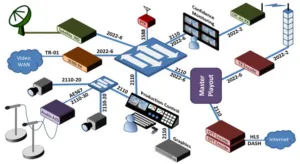I’ve just returned from Dallas, teaching several classes for a manufacturing client on networked audiovisual – compressing video and audio, encoding it with IP headers, and transporting it from Point A to Point B (and points beyond) over conventional IT networks.

Of all the changes I’ve seen in my 40 years working in the AV industry, this move to AV-over-IT (as it is correctly known) could be the most impactful trend I’ve seen, and not just because it will blur the line between the worlds of audiovisual and information technology. Rather, the migration to AV-over-IT is just one part of a massive transformation of the electronics industry away from expensive, proprietary hardware to commoditized products that largely have their origins in the consumer world.
Our Dallas class didn’t just focus on streaming video and audio. We also talked about wireless collaboration products that let people share their laptop, tablet, and smartphone screens on a large monitor or projected image. And we also demonstrated a new control system that is firmly rooted in the concept of Internet of Things, a system that can also collect data on who is controlling what AV gear and for how long (a/k/a analytics).
What’s more, we did all of this using an assortment of 1 Gb network switches and wireless routers and access points; none of which cost more than a couple hundred dollars apiece. Think about that – I was able to compress and distribute 1080p and Ultra HD video through a 16-port managed 1 Gb network switch that I picked up from Amazon for all of $190, plus shipping.
IP Video Ecosystem for Production, Post-Production and Broadcast (Image © 2017 by Wesley D. Simpson. Used with permission.)
So, what is the overarching trend here? With the continued decline in hardware prices and a more consumer-centric focus, the AV industry is shifting away from a “how it works” mentality to a “what do you do with it” mindset. I could and did explain to the class the differences between H.264 AVC and Motion JPEG encoding, but their primary interest was in how they can connect a video signal through an HDMI port to an encoder, run it through a network switch, and get it to a 70″ display in another part of the building.
Away from AV to Experiences
We’re already seeing the effects of commoditization on television technology. As a journalist and analyst, it becomes harder with each passing CES to get excited about the latest advances in TVs and monitors: Most of the news these days is about content distribution and “smart” TV features. Once again, “how it works” isn’t as important as how I use my new 55″ smart HDR Ultra HDTV (which is inexpensive enough that I can easily replace it next year if I wish to).
This shift has become so pronounced that InfoComm International recently changed its name to AVIXA, which stands for the Audio Visual Integrated eXperience Association. Going forward, the overarching focus of AVIXA will be on how the AV industry uses hardware and software to communicate. Of course, an increasing amount of that communication will be over network structures, streaming video and audio, sharing and collaborating on presentations, and monitoring and controlling AV gear and other stuff in the presentation space. (Which might not even be a defined presentation space, but just a couch and a couple of chairs.)
Makers are Rushing to Keep Up
Manufacturers are frantically trying to keep step with advances in the consumer electronics world. Look at all of the signal distribution and interfacing products that are labeled “4K ready!” or “4K compatible.” Never mind that 4K video and Ultra HDTV adoption is still at the very beginning of the curve in the AV industry (we’re still using 55-year-old RS232 control protocols, after all!) and that facilities managers are only just pondering if and how they can future-proof their AV installations to handle these signal formats…which will likely be transported over networks.
If you’re wondering how much of an impact the commoditization and networking of AV is having on manufacturers, look no further than the size of their booths at trade shows like NAB and InfoComm. When the majority of the products you sell have only two or three zeros in the price tag, you can’t devote nearly as much floor space to them.
In the CE world, the percentage of floor space that’s devoted to televisions at CES has declined, particularly among the big brands. There’s simply more money to be made selling white goods, smartphones, and other gadgets for the home. And the demos you see increasingly focus on “how you use it” applications, more often than not relying on a fast home wireless network to tie everything together.
Summing up; the world of AV signal distribution is going to look very different by the end of this decade. While we’ll still see advances in AV technology – most of them incremental and some significant – but the big story will continue to be about low-cost electronics that operate over ever-faster networks to deliver some sort of “experience” to the end-user. – Pete Putman

